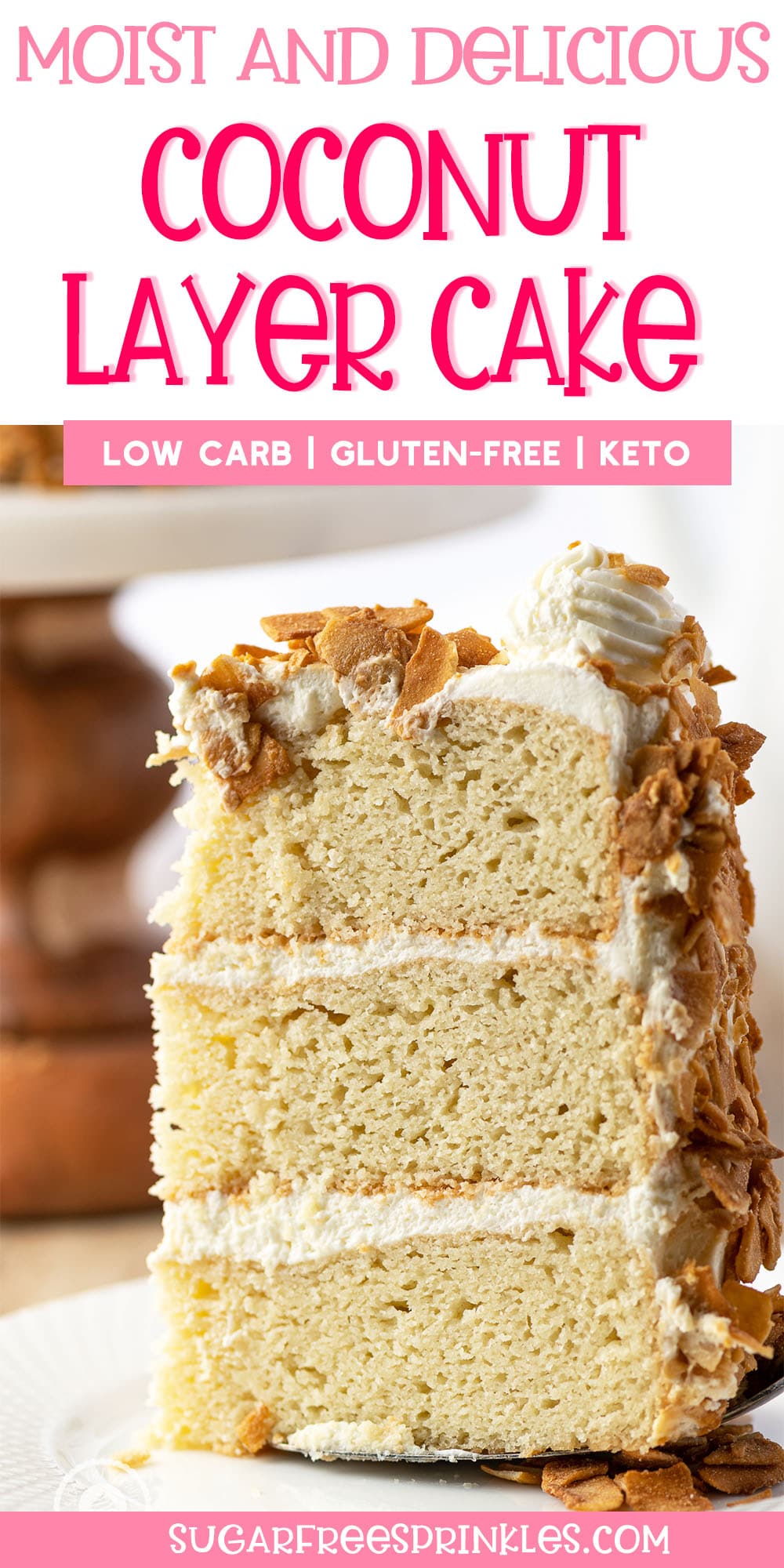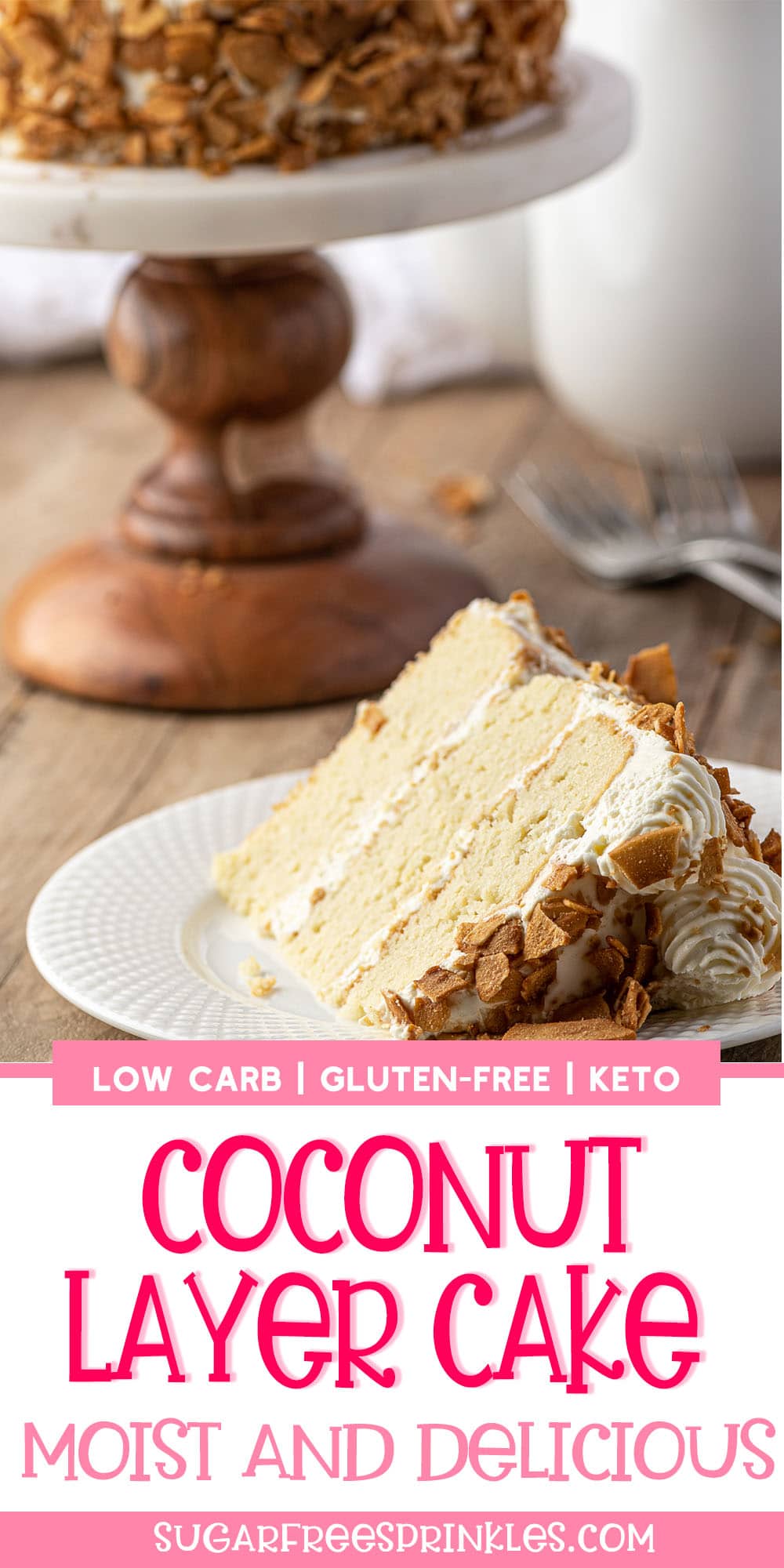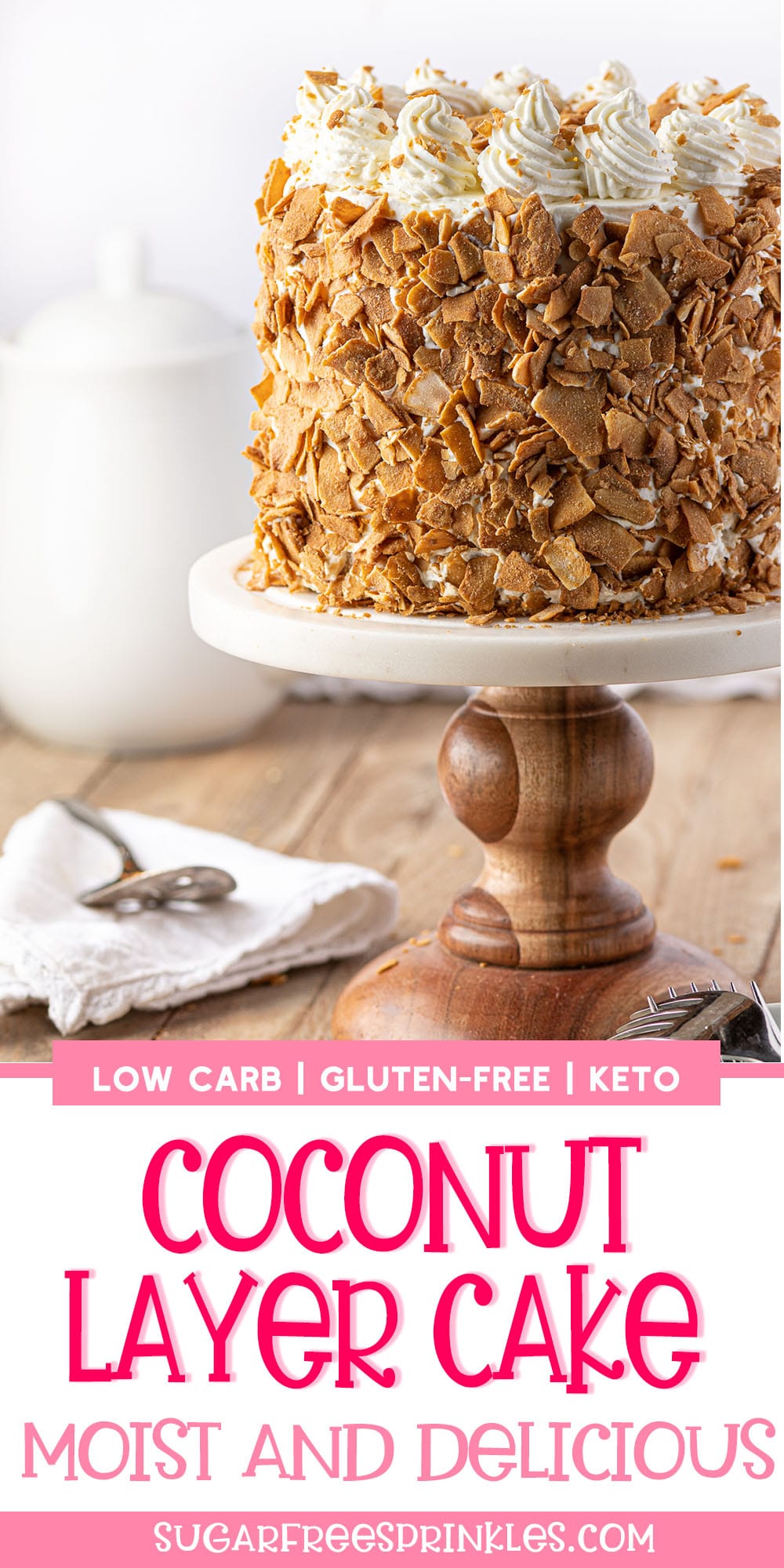I had an unreal craving for coconut this week. I don’t know where it came from but all of a sudden I was swimming in coconut desserts. The star of the week was by far this wonderful keto coconut cake.
If you like coconut, you will seriously love this dessert, it is filled with coconut in so many wonderful ways. From coconut oil, coconut milk, coconut flour, and more coconut, I mean the cake is seriously coco”nuts”.
See what I did there? That’s OK, my husband didn’t laugh either.
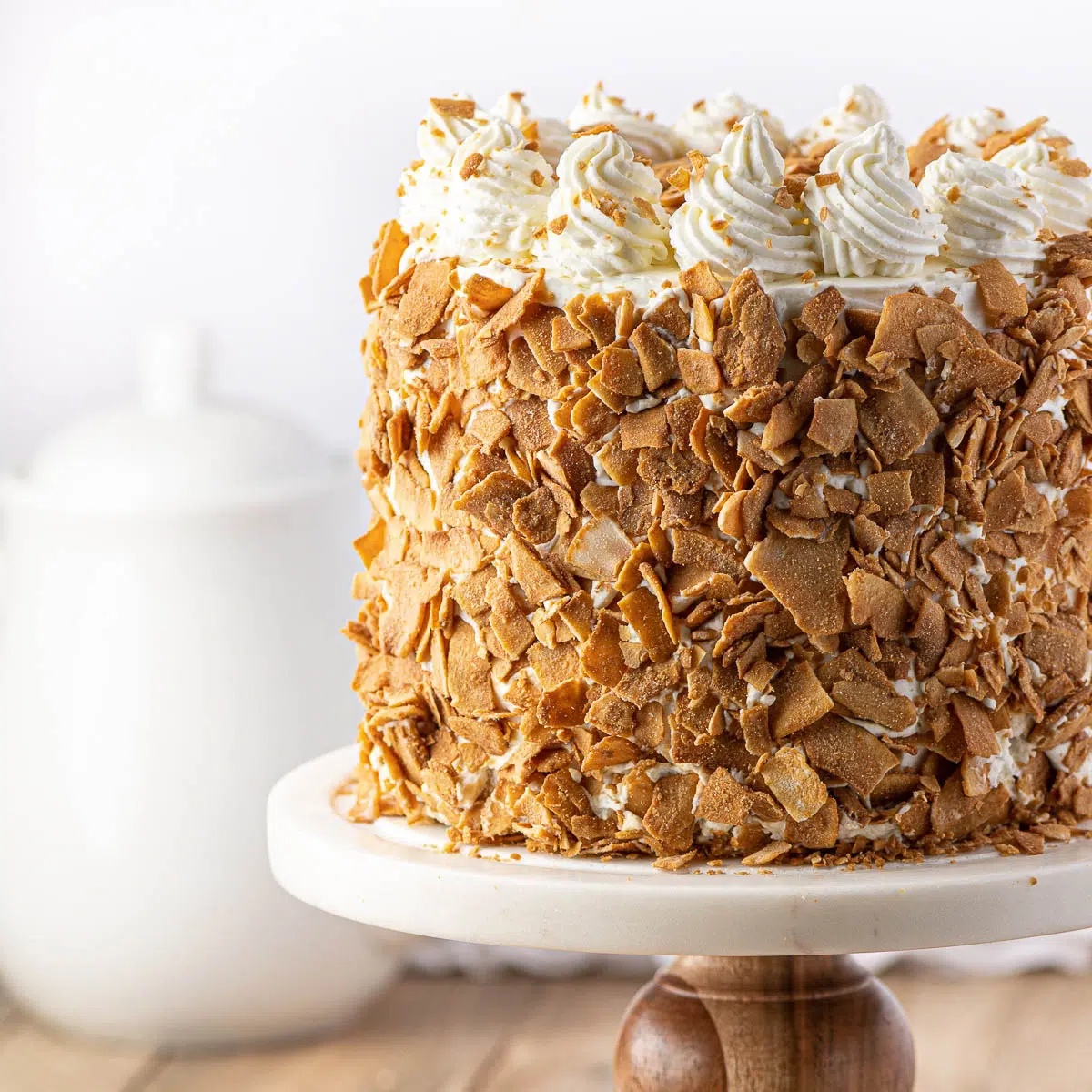
A Beautiful Low carb coconut Cake with No added refined sugars or gluten
And yet, it’s still delicious. This keto coconut cake is moist and sweet and bakes up in perfect professional-like layers. You don’t even have to level it out.
The cake is dense and has a great crumb. If you’re looking for a light and airy cake this isn’t the one for you. But if you’re wanting an old fashioned heavy crumb cake this is definitely the recipe you want. This is a cake-lovers cake.
The filling and topping is a sweet coconut flavoured cream-cheese whipped cream frosting that coats very well. You can also pipe on rosettes and they won’t sink, drop or melt.
The coating is simple flaked coconut sweetened with low carb sweetener and toasted.
You can make this keto coconut cake! I promise. It’s a great recipe for coconut lovers!
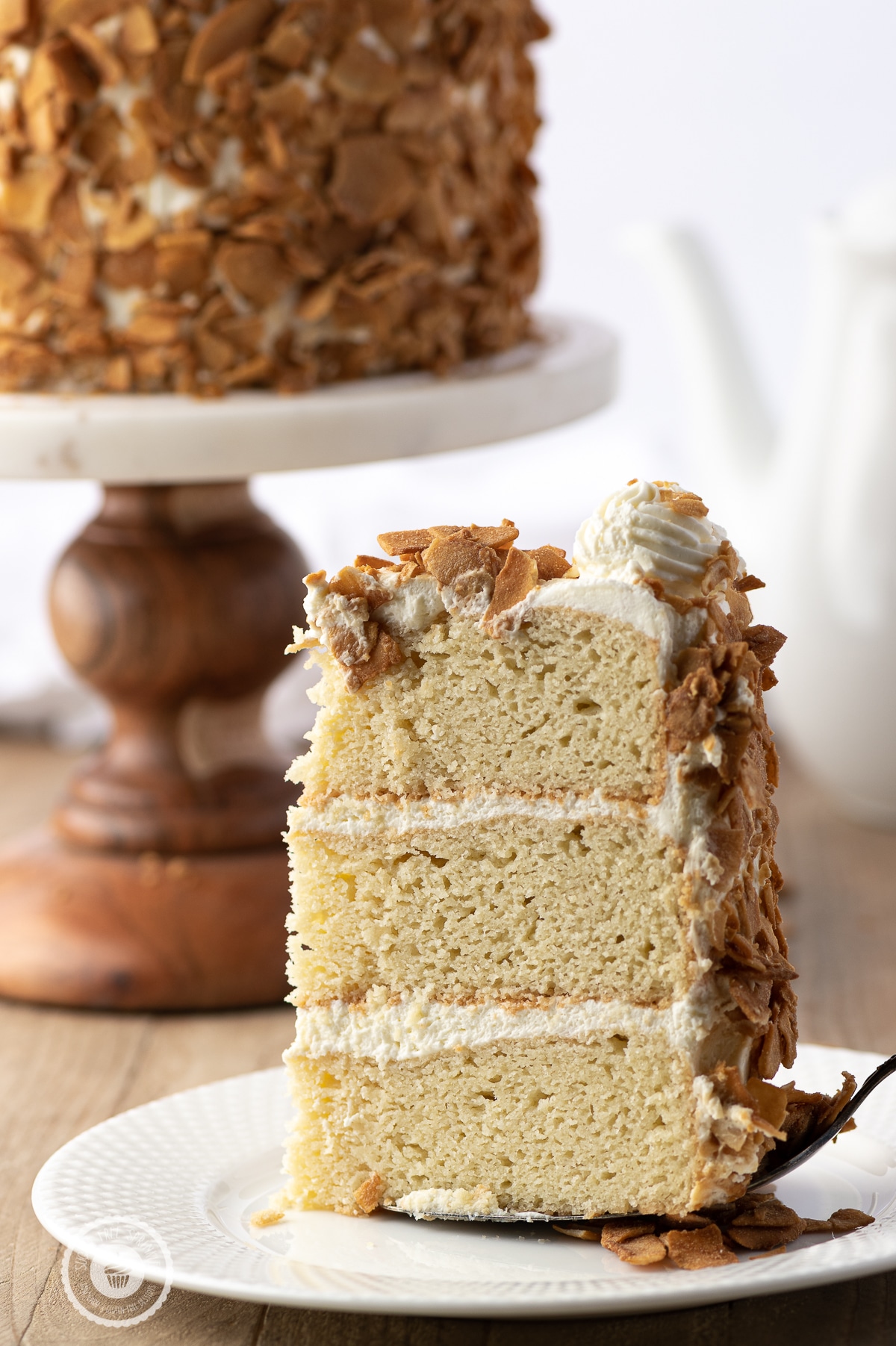
Ok so lets start with sweeteners, what can I use, and what can I substitue?
~This post may contain affiliate links. If you click one and make a purchase, I may receive a commission at no additional cost to you. I only ever recommend the ingredients or tools I use for my recipes. You can read more about our disclosure policy here ~
So the great thing about this recipe is you can sweeten it with any of your favorite powdered sweeteners.
I used a powdered erythritol for both the cake and the icing. You can use a granular sweetener in the cake, but to keep the frosting smooth I highly suggest you use a powdered version.
Allulose, monk fruit, erythritol, Swerve, or Pure will all work just fine.
Liquid sweeteners will not work as well, unfortunately, especially liquid drop sweeteners unless you adjust the balance of liquid to dry ingredients in the recipe.
Answers about Sweeteners, Low Carb Baking Tips, and General FAQ
For more detailed information about must-have baking tools and answers about sugar replacements, you can check out these FAQ pages.
We also have a handy sweetener replacement chart you can download for free!
Our FAQ Pages have answers to your biggest low carb baking questions including:
Tips for Baking With Almond Flour
Tips for Baking with Coconut Flour
Guides for Allulose, Monk Fruit, and Erythritol.
Substitutes for Xanthan Gum.
Tips for making sure the coconut cakes come out perfectly every single time
Low carb and gluten-free baking are not like regular baking. There are a few tricks you need to use in order to make your low carb baked goods rise, hold together, and taste good!
There are a few things you need to know about this recipe:
- The cake batter for this recipe is going to feel thick. It won’t pour into your cake pan. You will need to spoon it in and level it all out.
- You will also want to prep your pans with parchment paper.
- To prevent over-browning of the sides and bottom of your coconut flour recipes be sure to wrap your cake pans with tin foil. Low carb ingredients like coconut flour and some sweeteners tend to brown quickly. You can easily avoid this by using tin foil.
- Don’t skip the xanthan gum. Xanthan gum adds structure and holds the recipe together.
- Whip lots of air into your eggs before adding other ingredients. Whipping lightens the cake batter considerably.
- Don’t skip the apple cider vinegar. You can substitute lemon juice, but the extra acid is required to help those dense flours lift and rise in the oven.
- Be sure to sift all your dry ingredients. Sifting removes the irritating lumps from the flours and adds more air to the final batter.
- Ten minutes into baking cover the cakes with a piece of parchment paper or tin foil to prevent the tops from over-browning.
Follow these tips, and your cakes will come out perfectly every single time. It may seem like a lot of extra work, but it shows in the final results.
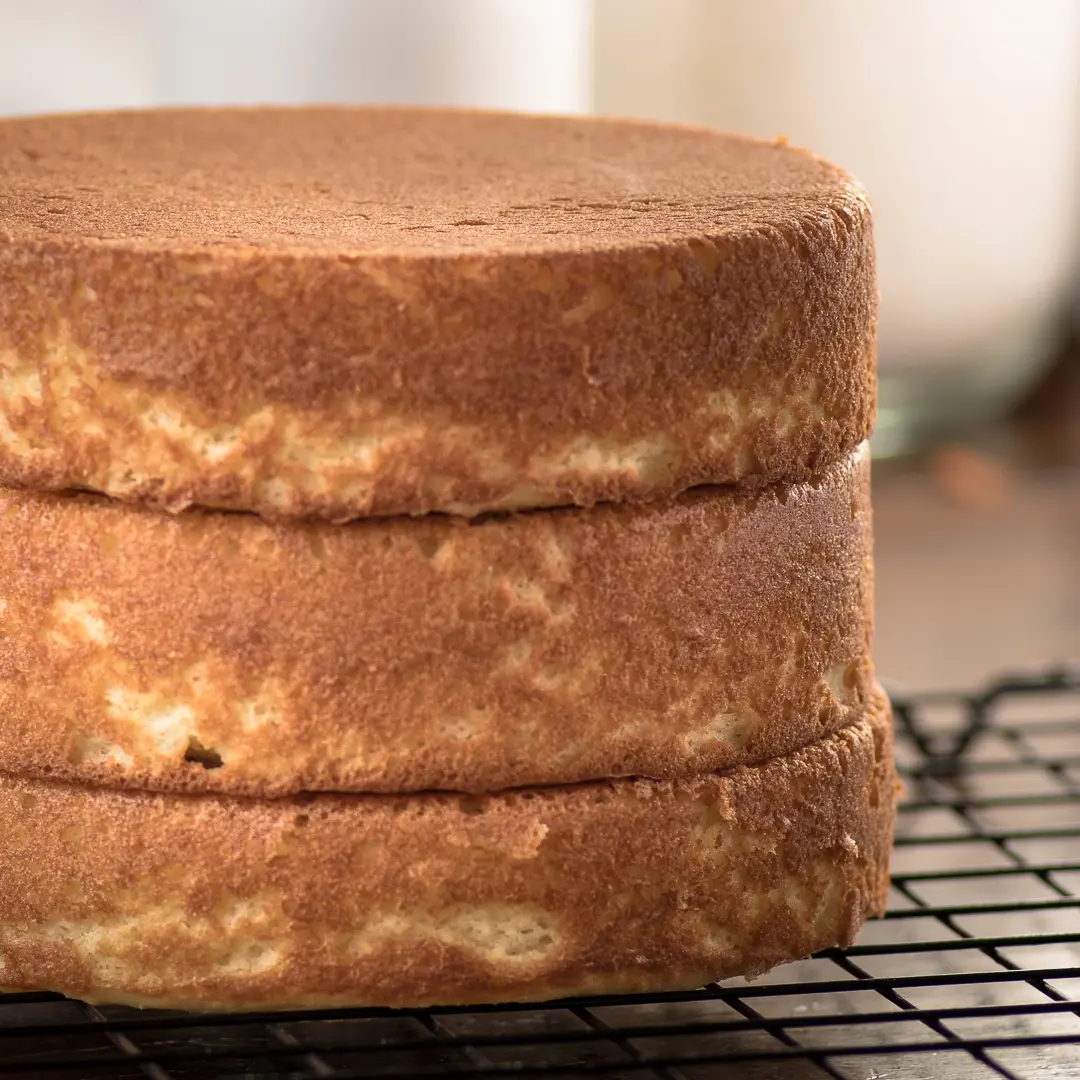
Tips for making the whipped coconut cream frosting
I call this frosting, but it is more like a stabilized whipped cream.
Here are some tips to make sure your whipped cream frosting comes out perfect every time.
- In a stand mixer, or with a hand mixer, whip cold cream cheese until it becomes spreadable.
- Scrape down the sides of the bowl to make sure all cream cheese bits are well blended.
- Add the heavy cream, flavoring, and sweetener to the bowl and mix on low until whip cream starts to blend with cream cheese. Add vanilla and emulsions and food coloring.
- Turn the mixer up and whip the mixture until soft and fluffy.
- If the icing begins to soften too much for spreading or piping, add it to the fridge for a few minutes to harden up a bit.
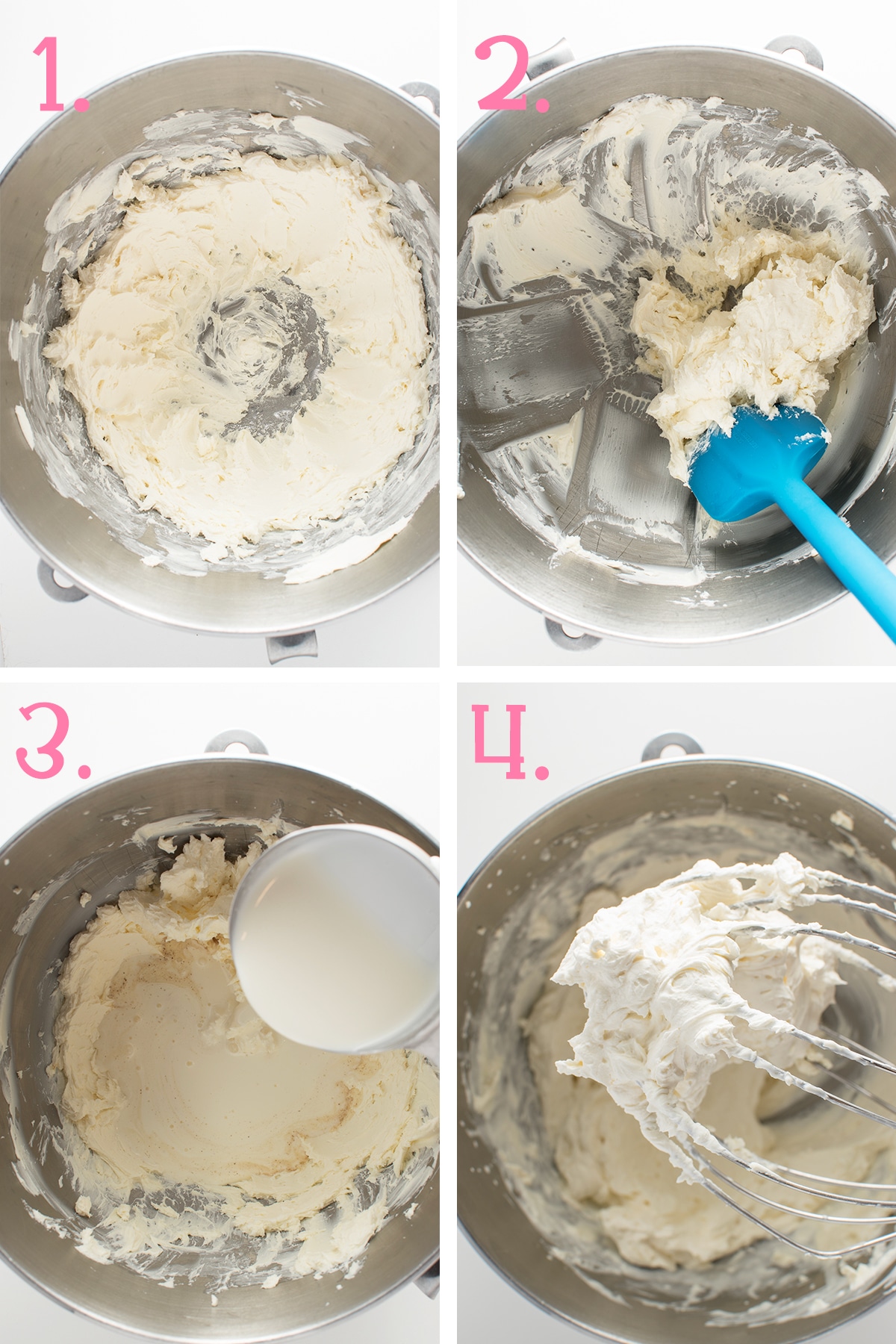
Tips for making the toasted coconut
The toasted coconut in this recipe is completely optional, but I really like the look of the coconut cake with the toasted coconut up the sides.
Making the coconut flakes takes a bit of patience.
You can lightly toast, or completely toast like I did. To get your coconut flakes toasted perfectly, you need to watch the coconut in the oven like a hawk, and stir it often to ensure it evenly browns and does not over brown. Trust me, it’s a fine line.
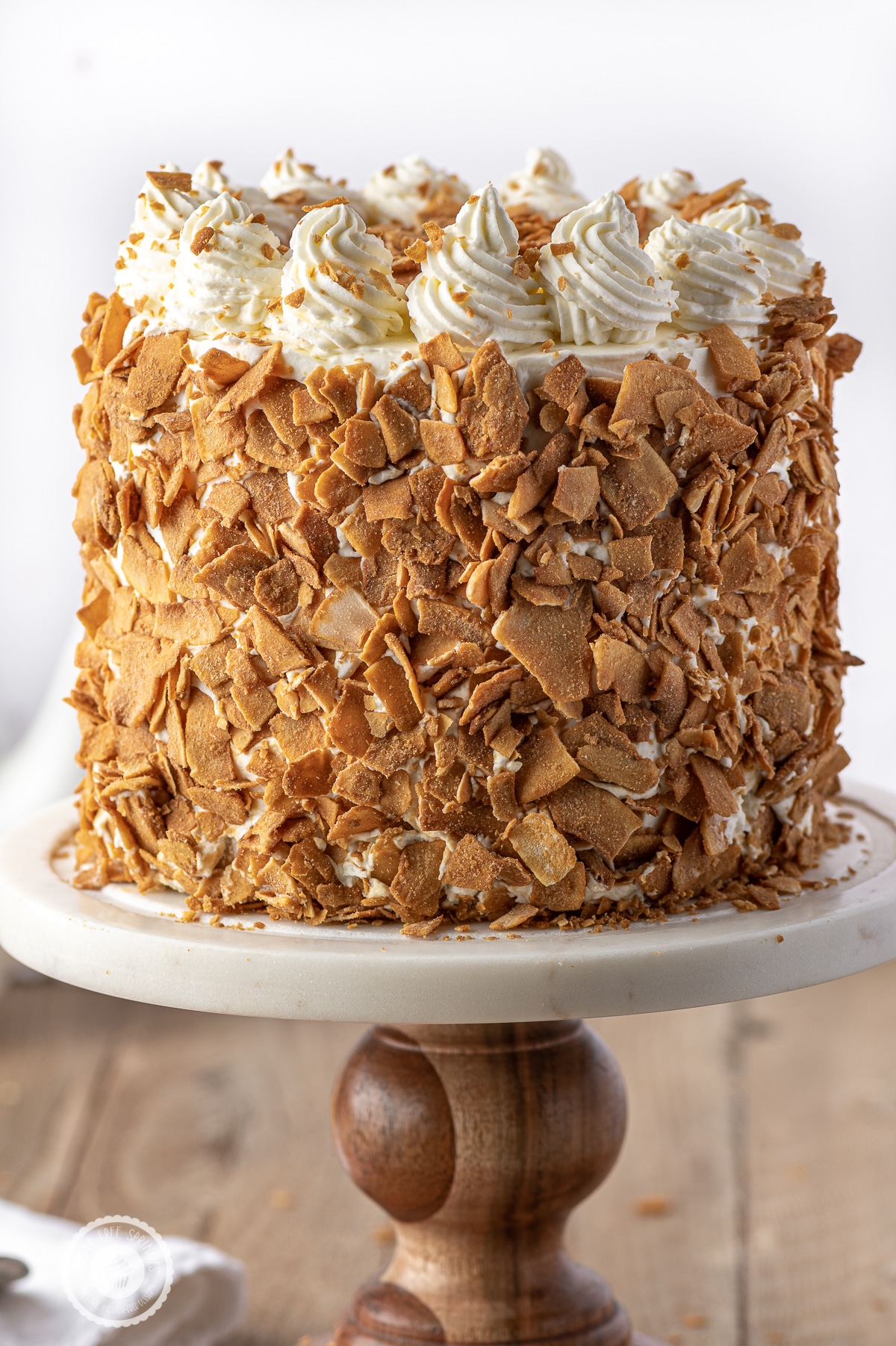
Serving Suggestions and storage suggestions
Ok, so the wonderful thing about this keto coconut cake recipe is that the baked cakes freeze wonderfully. you could make the cakes in advance, pull them out the night before, and let them defrost in the fridge. In the morning you can make your frosting and pull the cake together.
The cake lasts for days in the fridge, we were still eating ours three days out and it still tasted great. You will need to keep it covered so it does not dry out.
Definitely keep this cake in the fridge. The frosting holds up very well under warm temperatures, but it hardens up slightly in the fridge and I feel gives the whole thing a better mouth-feel.
This cake is absolutely wonderful with a tall ice cold glass of sugar-free vanilla almond milk.
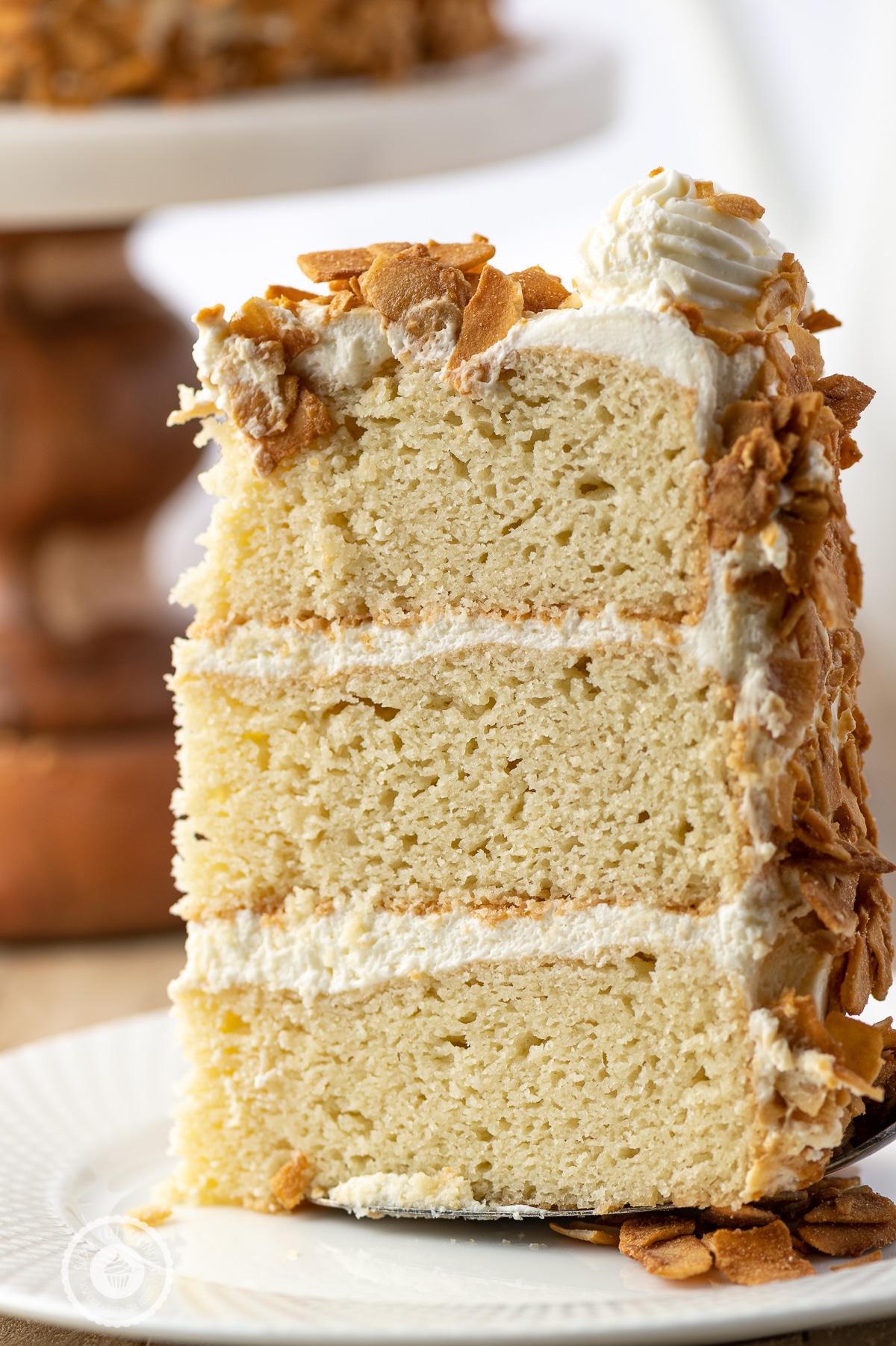
Looking for More Cakes That are Safe for Your Keto Diet?
And if you are looking for more keto desserts we have a few very popular cake recipes to enjoy without ruining your ketogenic diet:
- Cheesecake Stuffed Chocolate Bundt Cake
- Old Fashioned Cherry Chip Cake
- Luscious Lemon Layer Cake
- Low Carb Birthday Cake
- Black Forrest Keto Cake

Editorial Note: This recipe was originally published on June 22, 2020, and was updated on March 1, 2022.
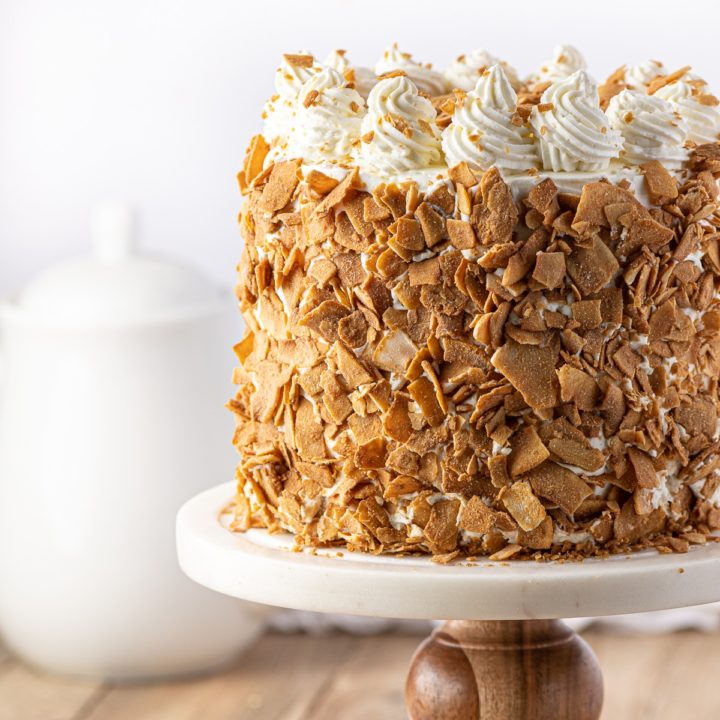
Keto Coconut Cake
A keto coconut cake layered with fresh whipped cream coconut frosting and toasted coconut coating.
Ingredients
Coconut Cake Batter
- 1 cup erythritol (powdered)
- 3/4 cup coconut oil
- 6 large eggs
- 2 large egg yolks
- 1/2 cup canned coconut milk
- 2 tsp apple cider vinegar
- 3 cups almond flour
- 1/2 cup coconut flour
- 1 Tbsp baking powder
- 1 tsp Xanthan gum powder
- 1 Tbsp vanilla extract
- 1/2 tsp coconut flavor extract
- 1/2 tsp salt
Coconut Frosting
- 1 tsp vanilla
- 1/2 tsp coconut extract
- 1 cup heavy whipping cream
- 1/2 cup erythritol (powdered)
- 1 cup (8 ounces) full-fat cream cheese
Toasted Coconut
- 1 1/2 cups large flaked coconut
- 1/4 cup powdered erythritol
- 1 tsp coconut oil
Instructions
Cake Batter
- Preheat oven to 350F and prepare cake pans by greasing well and adding parchment. To prevent the cakes from over-browning add tin foil to the outside of the pans.
- Add whole eggs & egg yolks to a mixing bowl and whip on high with an electric mixer for 2 minutes.
- Melt the coconut oil in the microwave, but do not overheat. We want it soft, but not too hot.
- Add vanilla, coconut milk, melted coconut oil, apple cider vinegar, and coconut extract to egg mixture and blend until well incorporated.
- Sift coconut flour, almond flour, baking powder, Xanthan gum, salt, and powdered erythritol in a separate bowl.
- Gently fold the egg mixture to the dry ingredient mixture. Do not over mix.
- Divide batter between two 9 inch cake rounds (or three 6 inch cake rounds).
- Bake in a 350F oven for 30-35 minutes. At the 10 minute mark, add a piece of tin foil or parchment and loosely cover the tops of the cake pans. The cakes are finished baking when a toothpick inserted in the center comes out clean. Overbaking will cause cakes to be dry.
- Cool in cake tins for 10 minutes before inverting on a cooling rack. Cool completely before adding frosting.
Whipped Cream Frosting
- Cube one cup of cold full-fat cream cheese and add it to the bowl of a stand mixer and blend for 1 minute, until the cream cheese has no lumps. Scrape down the sides of the bowl if necessary.
- Add vanilla, coconut extract, and powdered erythritol and blend for 30 seconds.
- Add 1 cup of full-fat whipping cream to the bowl and mix on low for 30 seconds, until blended with cream cheese. Turn up to medium and then high until the whipped cream and cream cheese fluff up and resemble buttercream frosting.
- Do not overbeat. Over beating will cause the mixture to liquefy.
Toasted Coconut
- Preheat oven to 325F
- Place large flaked coconut on a cookie sheet prepared with parchment paper. Add melted coconut oil and massage oil into coconut until the coconut is completely coated.
- Sprinkle the powdered sweetener over the top and blend in to make sure coconut is fully coated.
- Spread coconut out and place in the oven.
- Stir and move the coconut around on the cookie tray every five minutes to evenly brown. Remove from the oven when the coconut has reached a golden brown color. Do not over bake and keep a close eye on the coconut as it will burn easily.
- Once the toasted coconut has completely cooled, press it into sides of the frosted cake and top. Add a few rosettes to the top of the cake and use the small coconut dust pieces to add a dusting of coconut over the rosettes.
Notes
Recommended Products
As an Amazon Associate and member of other affiliate programs, I earn from qualifying purchases.
Nutrition Information:
Yield: 14 Serving Size: 1Amount Per Serving: Calories: 444Total Fat: 39gSaturated Fat: 21gTrans Fat: 0gUnsaturated Fat: 15gCholesterol: 103mgSodium: 277mgCarbohydrates: 10.3gNet Carbohydrates: 5.5gFiber: 4.8gSugar: 3.2gProtein: 10g
Nutritional information for the recipe is provided as a courtesy and is approximate only. We cannot guarantee the accuracy of the nutritional information given for any recipe on this site. Erythritol carbs (and sugar alcohols) are not included in carb counts as it has been shown not to impact blood sugar. Net carbs are the total carbs minus fibre.
